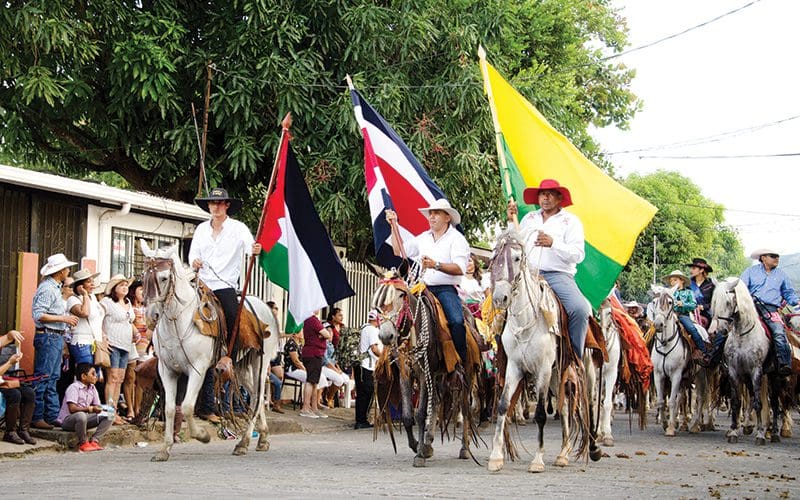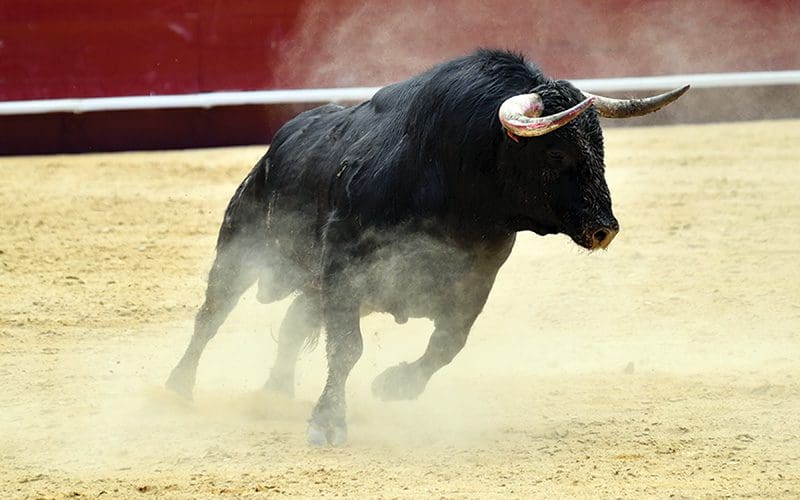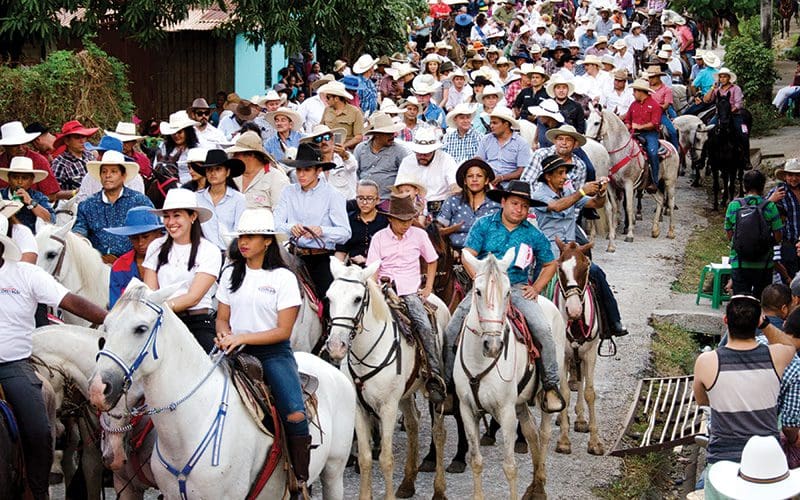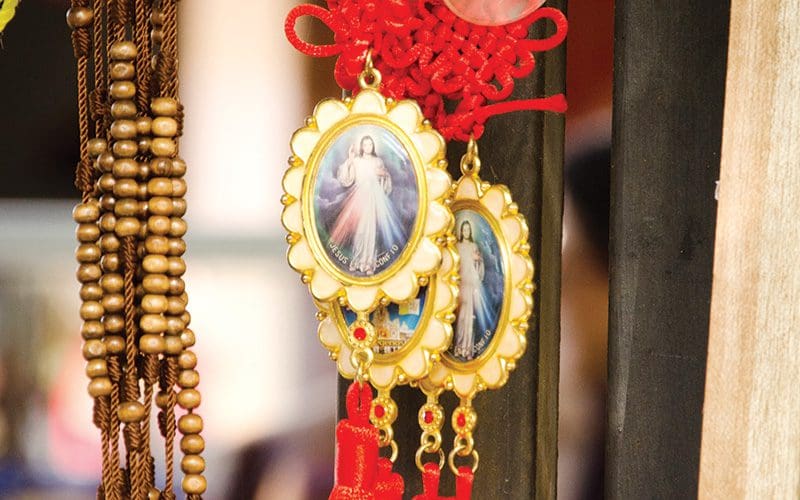
Las Fiestas — Viva Costa Rica!
As the rains taper off and winds pick up, Costa Ricans dust off their cowboy boots and hats. Fiesta season is upon us in the town square fútbol (soccer) fields throughout the country. Each festival (synonymous with fiesta) is a showcase for local communities to celebrate a custom dating back to colonial times.
It’s a trip to the
emergency room and a
lifetime of bragging rights.
Tico-style bullring action
Nothing speaks to Costa Rica’s fiesta heritage more vividly than the running of the bulls “a lo Tico” (Tico style) — a cross between a rodeo and something totally unique. The first bull runs were set up in San José for celebrating the crowning of the king of Spain and for civic celebrations. That’s where similarities with the Spanish-based tradition of bullfights end. Tico style bull running took Costa Rica in an entirely different direction, minus the stylized costumes and fanfare. The Tico version is more an exhibition and celebration of the bull’s virility and strength in the face of the common man. This is quite unlike the Spanish tradition of a ballet between the matador, picador and bull, culminating with the bull eventually being killed in a most bloody manner. It represents the domination of man over beast.

Costa Rica’s adaptation is much more about the human-beast synergy and respect for the animal’s strength and power. It is more comparable to American rodeo riders getting on the bull’s back and seeing how long they can hold on using different sitting positions. But here is where things go a lo Tico. Once the rider is knocked off, the men sitting on top of the wooden bull ring jump into the ring and taunt the bull before running away. Then it’s every man for himself, with the crowd standing on bated breath as their young boys and men come dangerously close to harm’s way. Ultimately, the bull is taken out of the ring and a new one put in. As the night proceeds, the size and strength of successive bulls increase.
This jumping into the ring is the biggest difference between the bull-centered traditions of Spain and Costa Rica. For centuries, it has been a right of passage for young Tico men to jump into the ring, demonstrating their virility and fearlessness of the beast as their whole community watches. In recent years, women have also joined the action. It is not uncommon to be shown wounds and scars from Ticos and expats alike who were gored by the bull and even thrown in the air. Fatalities are rare but do happen; more commonly, it’s a trip to the emergency room and a lifetime of bragging rights.
Named for patron saints
The customary festival for every town began in the late 1800s when Costa Rica started producing cattle, around the time of realizing the population could not live from coffee production alone. Festivals became “patronal,” meaning a week-long celebration of each Central Valley town’s patron saint. That’s where the biggest festivals in the country still take place and the Zapote fiesta became the most important. This festival surpasses all the others not just in size but in length and profile, lasting from Christmas through New Year’s and televised throughout the country. You cannot travel during this season without seeing it on every television set in the country. This juxtaposition of the Christmas holiday and excitement of a good gorging can be startling at first, however much the gorged hero enjoys his 15 minutes of fame in televised news reports on every station.
Horses in the spotlight
Outside the Central Valley, Liberia’s fiesta, also televised, gains special cultural significance from its renowned tope, a horse exhibition and parade featuring riders from all parts of Guanacaste and the country. The Liberia fiesta, held at the end of February, offers traditional food from the area and traditional dress — think colonial cowboy.
An important tope figures prominently in the Palmares festival as well. Top riders from around the country participate in exhibitions of horses prancing and performing. Palmares celebrates its festival in the first week of January.
Shopping fun and food fare
There is much more to Costa Rica’s fiestas outside the bullring. Like the traveling circuses of old, fiestas bring with them caravans of cheap goods, traditional fair foods and portable dance floors. It all starts some weeks before the actual event when work is started to build the redondel, the wooden stands and ring analogous to the circus big top. The local builders come in and take days to painstakingly build the wooden bull enclosure and it is the ultimate advertisement to attract a crowd. Then a few days before the festival start date, vendors arrive with their caravan-style kiosks to sell anything from shoes and clothes to toys, knick-knacks and mini-head shop items. You can still get a sense of the past from what would have once been the town’s main access to goods from the city.
Fiestas also have traditional rides for all ages, including bumper cars, a ferris wheel and some spinning ride sure to make you remember what g-force is, as well as a few kiddie rides.
Food is another big reason people flock to fiestas. The traditional Costa Rican fair food is fried rice and chop suey, which dates back to a huge Chinese migration some 50 years ago. Every fiesta menu also features pupusas — pork-stuffed corn tortillas that are then opened and stuffed with cabbage and spicy vegetables. For your sweet tooth, there are always churros — a caramel stuffed donut tube. In recent years, pizza trucks have become a staple, as well as Argentinian steak and pincho (shish kabob).
Party hearty
Even if you don’t like bulls or you don’t enjoy rides, and the same goes for toy or knick-knack shopping and yummy food, there is still one more reason to head to the fiestas: the party. If you have ever wondered how Ticos party, simply head to a local fiesta. Check out the dance floors and bars, where Imperial and Pilsen flow freely. As the children get tired of their sugar rush and rides, the adults start dancing.
Fiestas can go on all night; the level of drunkenness is proportional to the lateness of night or earliness of morning. Dawn can shine its light on drunk bodies passed out and awaiting pick-up by spouses and family members. This … only to begin again the next night. Fiestas last minimally a week. It’s the one occasion a year when locals can let their hair down, since all other holidays are either civic or religious.
Your local communities will each have fiestas. Fiestas are the place to see the faces of your neighbors and spend time with your family. Bring cash because credit cards aren’t accepted and costs add up. The beginning of the night is full of happy squealing children. When the bulls start running, the community becomes mesmerized watching their men and boys show their fearlessness. After the bulls comes the party and dancing all night long. Wherever you are in Costa Rica fiestas are a step into tradition and community celebration a lo Tico.
When? We’ve tried to find out, but…
Watch for schedules, signs and preparation activity in your area. The Howler has tried hard, but so far has been unable to come up with any comprehensive list of fiesta dates covering the entire season and country. Our goal is to become the go-to source of this information for people visiting or living in Costa Rica, so we’ll keep on trying.
Otto Apuy – Multimedia Artist
Envision Festival Spotlights International Artists
Max Gea – Musician
Juan Carlos Camacho – Blending of Art and Architecture
Joe Hrbek – Gold Coast’s Iron Sax Man
Stephanie Waltrip – Musician
David Villalobos – Young and the Restless
Rebeca Alvarado Soto: The art of the dance
Fiery Flamenco Guitar
Leatherback Rock
Marvin Dolgay – Musician



